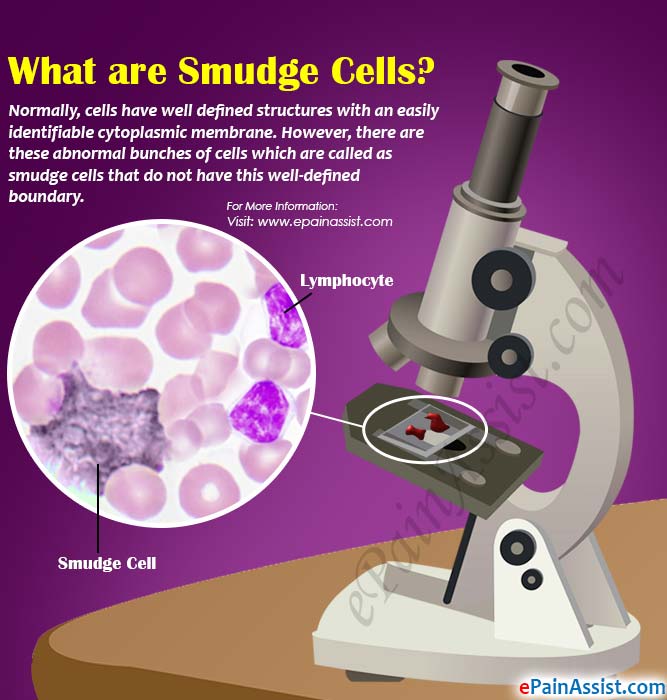What are Smudge Cells?
Normally, cells have well defined structures with an easily identifiable cytoplasmic membrane. However, there are these abnormal bunches of cells which are called as smudge cells that do not have this well-defined boundary. They are actually the remains of the dead lymphocytes that have combined together into groups. Hence, they are also known as Basket Cells.
Smudge cells are often included into the classification of lymphocytes. Some people think that these cells are found only on the unhealthy lymphocytes but they can also occur on those lymphocytes that are weak.

You can clearly see how the smudge cells get clumped up together to appear as a dark violet patch in the above image. You must also note that only the violet patches on the left are smudge cells while the three in the middle are developing lymphocytes.
What Causes Smudge Cells?
To understand the reason behind the formation of smudge cells, we need to first discuss about a condition known as Chronic Lymphocytic Leukemia (CLL). This abnormal condition results due to excess production of lymphocytes by bone marrow. Among the various types of Leukemia that can affect a person, Chronic Lymphocytic Leukemia is one of the most common. This condition tends to become worse with the passing of time. Now, let us try to understand as to how this condition is related to the formation of smudge cells.
The formation of smudge cells is complicated. In normal cells, the nucleus occupies only a small portion of the cell while in case of CLL, it can occupy the entire cell. When an external pressure is applied, the thin cytoplasmic tends to get crushed as it is unable to take the pressure. This leads to the formation of smudge cells. One of the most common causes behind the formation of the smudge cells is the preparation of the blood films. Thus, expertise is desired in this area to prevent the formation of the smudge cells.
One needs to be very careful while handling the slide spreader. If you are not an expert at this, you can easily end up tilting the slide spreader more. This can cause the blood to spread out quickly and creating thick films of blood over the slide. On the other hand, if the slide is tilted to an angle lower than the desired, you can have even cell distribution.
Differential Diagnosis of Smudge Cells
The differential diagnosis of the smudge cells involves counting the lymphocytes to find out its relative differential count. It is usually 0.24 which is sometime represented as 24% of the total number of white blood cells present in the body.
When we compare these figures with the white blood cell differential count, we can easily figure out the mismatch between the figures. We can say this because all relative counts must give an equivalent value of 1.0. Also, the absolute counts must produce an equivalent value that is identical to the absolute count of white blood cells.
Modern medical instruments are getting better in differentiating lymphocytes from the smudge cells and thus producing the accurate results for relative and absolute counts. Constant increment in the absolute count of lymphocytes makes you more vulnerable to CCL and other lymphoproliferative disorders.
- American Journal of Clinical Pathology. (2016). Smudge Cells: Extended Insight into a Well-Known but Underappreciated Morphologic Entity in Hematology. Retrieved from https://academic.oup.com/ajcp/article/146/4/427/1762093
- Leukemia & Lymphoma Society. (2022). Chronic Lymphocytic Leukemia (CLL). Retrieved from https://www.lls.org/leukemia/chronic-lymphocytic-leukemia
- LabCE. (n.d.). Peripheral Blood Smear Review: Smudge Cells. Retrieved from https://www.labce.com/spg257028_peripheral_blood_smear_review_smudge_cells.aspx
